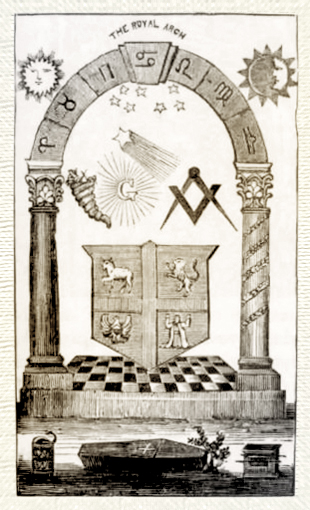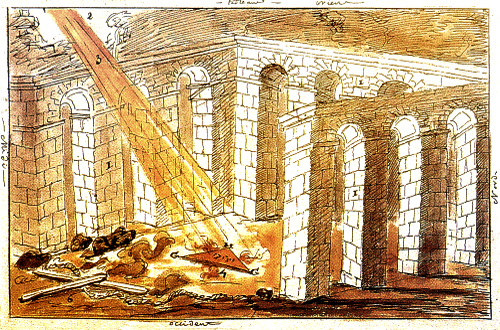Origins of the Holy Royal Arch
 |
A quick examination of the conditions of English Freemasonry in early 1701 provides a useful contribution to the understanding of the historical reasons that favored the rise of the Order of the Royal Arch of Jerusalem within Freemasonry. However, it is noted that the English Masonic activities existed in periods prior to that date, as evidenced by the London Company of Freemasons (1621), as well as many documents show that in 1600 there were operative lodges in Scotland and speculative lodges in England. About the speculative lodges B. Jones writes:
"We know very little of their ceremonies but we have reason to believe that they were simple with little ceremonial formalism, but they had something important on the esoteric matter."
|
|||
|
Originally the English Lodges had its own life and often different rituals, and only in 1717, four very famous lodges established the first Grand Lodge, headed by a Grand Master. The new Grand Lodge planned quarterly meetings, an annual celebration and gave a Constitution and Regulations that replaced the Old Duties of 1380. The first Constitution was approved and published in 1723. It was written by Dr. James Anderson, and in a title on "God and religion" they were expressed very different ideas from those ones set out in the Antient Charges. In a footnote to the mentioned title, Anderson expressed:
"I have to remind you of another thing and that is to avoid talking about politics and religion to encourage the unity of Masons on a platform that divides them as little as possible. Our religion is the religion of Nature, loving God above all things and our neighbor as ourselves. This was the true, primitive, catholic, universal religion established in all times and in all ages. "
From these words it is clear that Anderson was aiming to dechristianize English Freemasonry and indulged theistic theories of the time, but without giving in to the atheist argument. The Grand Lodge did not have at that time a lot of success either for the ideas it professed or because it assumed the right to give orders and instructions to other lodges and because the information went slowly around. It is meaningful that it took sixteen years from the enactment of the first Constitutions before the Grand Lodge of the Antient, that played an antagonistic role, was established. Another reason that contributed to the success of the Royal Arch, was the adoption of the three-degree system. It is the opinion of many scholars that before 1730 Freemasonry used to work with two or perhaps one degree. The adoption of the hiramic degree was useful to the Royal Arch. Bernard Jones writes on this subject:
"If there had not been such innovation, the Royal Arch, perhaps, would never have become an integral part of the Masonic Order. The Freemason of the ancient lodges was generally a religious and relatively simple soul, so the story of the legend of Hiram prepared him to another story that gave him two teachings not present in the initial degrees. " |
 |
|
 |
The founders of the first Grand Lodge (called "Moderns") did not like to be considered innovators, so they accepted, although unofficially, the Royal Arch to avoid leaving their opponents more chance. The moderns kept for a long time an ambiguous position toward the Arch: the official attitude was general reluctance, but unofficially the lodges practiced the ritual of the Arch and many officers of the Grand Lodge got excited.
|
|
What was the position of Freemasonry of the Royal Arch in the Grand Lodge is clear from the words of James Heseltine, Grand Secretary of the Moderns, a former officer of the Supreme Grand Chapter, which, in 1774, turning to Peter Gogel, former Grand Master of Frankfurt, wrote:
"It is true that many in the Brotherhood belong to a "degree" that should be higher than the others and it is called Royal Arch, I have the honor to belong to this" degree "but it is not recognized by the Grand Lodge. It is part of Freemasonry , but it has no connection with the Grand Lodge, and, for us in England, this is the only further degree we know. "
The Arch works that took place in a Lodge and the assigned titles were not allowed by a special note, as there was no authority to release it. This situation was common to the two English Grand Lodges, to Scotland and Ireland, but it could not be considered "regular." In England the "Moderns" did not even remotely think of doing something in order to regularize the practice, which has become increasingly common, to exalt Masters as companion in the Royal Arch in the lodges. The Antients, who delighted in fame and the advantage of being known as the Grand Lodge of the four degrees, continued to exalt Masters in their lodges, considering it a normal and regular practice. The general situation was modified in 1766, on the initiative of the Grand Master of the Moderns Lord Blayney, who signed the bill of constitution of the Excellent Grand Royal Chapter that, in 1811, changed its name to Supreme Grand Chapter. The act establishing the Excellent Grand Royal Chapter is the fundamental document of the Arch: it is generally referred to as the "Charter of Compact" that is the foundation and protection charter, and, in spite of the different date expressed as lime, it dates back to July, 30th 1766. To complete the synthetic historical context it seems appropriate to mention the Act of Union in December 1813 that even today can be read as a declaration prior to the Constitution of the United Grand Lodge of England.
|
||
 |
It says:
Pursuant to the Declaration of 1813 in the English system the Royal Arch is an integral part of Freemasonry, so the Grand Master of the United Grand Lodge of England is the First Grand Principal of the Supreme Grand Chapter and the Grand Officers, if first principal, are officers of the Supreme Grand Chapter, with the corresponding title. The chapters are always connected to a lodge and have the same number and distinctive title. The exaltation in a chapter does not confer a degree. The chapters are governed by the Supreme Grand Chapter, which has its own regulations. |
|
|
Different form and arrangement are assigned to the Arch in Scotland, Ireland and the United States. However, the different bodies in the United Kingdom maintain mutual recognition and fraternal relations and likewise with Italy.
|
||
